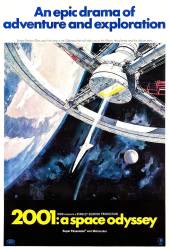Trivia: Much has been written about the scene where Bowman enters the air lock without his helmet. Studies done by NASA have shown that humans can survive in vacuum for brief periods if they do not hold their breath. Some have commented that Dave appears to hold his breath before blowing the hatch, but careful study of the scene does not show this, as it seems he is simply grimacing, bracing himself for the coming effort. When the film was first shown in theaters, many of them handed out souvenir booklets which included references to this study.

2001: A Space Odyssey (1968)
22 trivia entries
Directed by: Stanley Kubrick
Starring: Gary Lockwood, Keir Dullea, William Sylvester, Daniel Richter
Revealing mistake: When we see the space station from the cockpit of the approaching shuttle, the station does not appear to rotate because the shuttle is rotating at the same speed. OK...except that the station IS still rotating with respect to the sun, which means that the light source and shadows on the station should be moving.
Dave Bowman: Open the pod bay doors, HAL.
HAL: I'm sorry Dave, I'm afraid I can't do that.
Question: What was the ultimate destination of the Jupiter mission? The giant planet is made of gas, it has no solid surface to land on. Theoretically a spacecraft could land on one of Jupiter's moons, but they lie within the lethal radiation belt.
Answer: The objective of the Discovery (Jupiter) mission was to locate the recipient of the powerful radio signal that was transmitted from the Moon earlier in the movie. Interestingly, the destination of the Discovery mission changed between Jupiter to Saturn and back to Jupiter during the production of the film. The Jupiter visual effects had already been shot ("in the can" as it were) when Stanley Kubrick decided to change to Saturn. It was the protest of the visual effects team, who had already spent much time and money on the Jupiter effects, that convinced Kubrick to stay with Jupiter. In the meantime, author Arthur C. Clarke went ahead and changed the destination to Saturn in his written treatment of the movie.





Answer: The ultimate goal was to orbit Jupiter to study the Monolith also in orbit around it.
Grumpy Scot